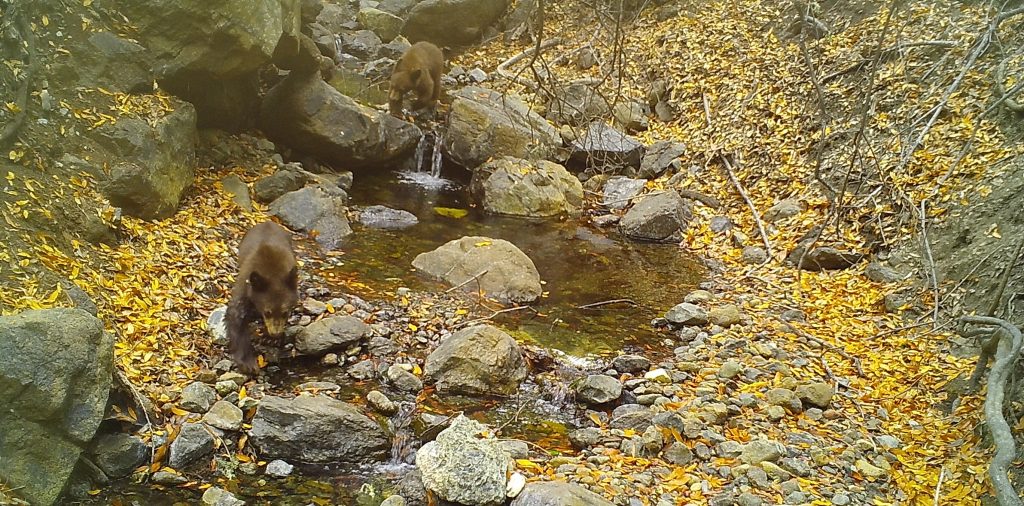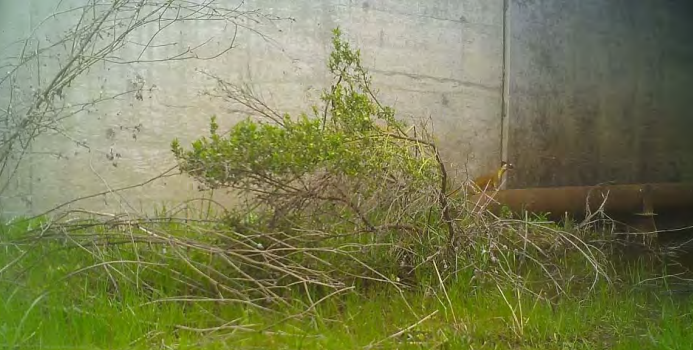We are fortunate to live in a place where wildlife is a common sight. As many of the animals that inhabit the watershed are elusive, motion-activated cameras allow us a glimpse into the secret lives of local wildlife.

Wildlife Camera Deployments
From 2018 to 2020, the Estuary Program partnered with Dr. John Perrine of Cal Poly on a Community Project to document wildlife activity throughout the watershed. Dr. Perrine and his students deployed motion-activated cameras to determine what types of wildlife were present in the watershed. From June to November of 2022, Estuary Program staff deployed two wildlife cameras at upper Pennington Creek.
The Importance of Riparian Areas
A riparian area is a vegetated area next to water bodies like our local creeks that offer shelter, food, moderate temperatures, and migratory corridors for many wildlife species. These unique environments are hotspots of biodiversity. In fact, about 60% of all vertebrate species and 70% of threatened and endangered species in the U.S. depend on riparian systems to survive. This makes these areas a natural location for placing wildlife cameras.

Upon retrieving the Pennington Creek cameras last fall, Estuary Program staff discovered that one camera had been dismantled by a squirrel shortly after deployment. Fortunately, the second camera remained undisturbed and was able to capture images of an astounding amount of wildlife activity in the riparian area.
Between the Cal Poly and Estuary Program deployments, the cameras detected species including black bears, mountain lions, bobcats, mule deer, gray foxes, red foxes, coyotes, striped skunks, opossums, raccoons, wild pigs, wild turkeys, red-tailed hawks, great blue herons, great-horned owls, great egrets, doves, cottontail rabbits, jackrabbits, squirrels, rats, and mice.

Black Bear
While many of the animals we documented are ones that are frequently observed around the watershed, species like the black bear are much less common. The California Department of Fish and Wildlife (CDFW) estimates that California’s black bear population has increased in recent decades to around 30,000 to 40,000 individuals. Black bears are found throughout the local Santa Lucia Mountain range and can vary in color between tan, brown, and black.

Long-Tailed Weasel
Another elusive animal species captured by the cameras was the long-tailed weasel. According to the Ojai Valley Land Conservancy, long-tailed weasels den in burrows or cavities in stumps and rock piles. Their excellent climbing and swimming abilities allow them to pursue prey such as fish, birds, rabbits, reptiles, and rodents. While sightings may be relatively uncommon, long-tailed weasel populations are considered stable.

Mountain Lion
Another notable species captured on the cameras was the mountain lion. CDFW estimates that there are 2,000 to 6,000 mountain lions in California. While their overall population is considered stable, the species is impacted by a lack of connected habitat in Southern California and along the central coast.

With a reduction in their habitat, human-mountain lion interactions are becoming more frequent. Learn more from the National Park Service about how to behave if you encounter a mountain lion.

Coexisting in our Community

Wildlife camera deployments provide a glimpse into a hidden, bustling world of wildlife in the watershed. Whether it was under the cover of nightfall or simply in remote locations, the cameras revealed many rarely-seen animals. While the red fox and wild pig are non-native, the other observed animals are native species that have occupied the area for thousands of years. As stewards of this special place, it is important to know that these creatures are here, coexisting with our community, whether we see them or not.
References California Department of Fish and Wildlife. “Mountain Lions in California”. Accessed December 14th, 2022. https://wildlife.ca.gov/Conservation/Mammals/Mountain-Lion#56231950-conservation-and-management California Department of Fish and Wildlife. “Black Bear”. Accessed December 7th, 2022. https://wildlife. ca.gov/Conservation/Mammals/Black-Bear/Population#572681132-science-and-research Hopkins, Jaran. Advised by Dr. John Perrine. Morro Bay Watershed Wildlife Photo Inventory. Summary Report: Fall 2018 and Winter 2019, n. d. Biological Sciences Department, California Polytechnic State University, San Luis Obispo. IUCN Red List. “Long-tailed Weasel. Mustela frenata”. IUCN Red List of Threatened Species, 2016. https://www.iucnredlist.org/species/41654/45213820 Ojai Valley Land Conservancy. “Long-tailed Weasel. Mustela Frenata (Subspecies: California Weasel, Mustela F. Xanthogenys)”. Accessed December 14th, 2022. https://ovlc.org/ojai-wildlife/long-tailed-weasel/ Oregon State University. “An overview of riparian systems and potential problems”. OSU Extension Service. Accessed December 15th, 2022. https://extension.oregonstate.edu/water /riparian-areas/overview-riparian-systems-potential-problems Peria, Lindsay. Advised by Dr. John Perrine. Morro Bay Watershed Wildlife Inventory. Winter/Spring 2020 Summary Report, n. d. Biological Sciences Department, California Polytechnic State University, San Luis Obispo. Winn, Cheyenne. Letter to Ann Kitajima. Game Camera Photos, December 20, 2022.
Help us protect and restore the Morro Bay estuary!
- Donate to the Estuary Program today and support our work in the field, the lab, and beyond.
The Estuary Program is a 501(c)3 nonprofit. We depend on funding from grants and generous donors to continue our work. - Support us by purchasing estuary-themed gear from ESTERO. This locally owned and operated company donates 20% of proceeds from its Estuary clothing line and 100% of Estuary decal proceeds to the Estuary Program. Thank you, ESTERO!
- Purchase items from the Estuary Program’s store on Zazzle. Zazzle prints and ships your items, and the Estuary Program receives 10% of the proceeds. Choose from mugs, hats, t-shirts, and even fanny packs (they’re back!) with our fun Estuary Octopus design, our classic Estuary Program logo, or our Mutts for the Bay logo.
Thank you for helping our beautiful, bountiful, biodiverse bay!